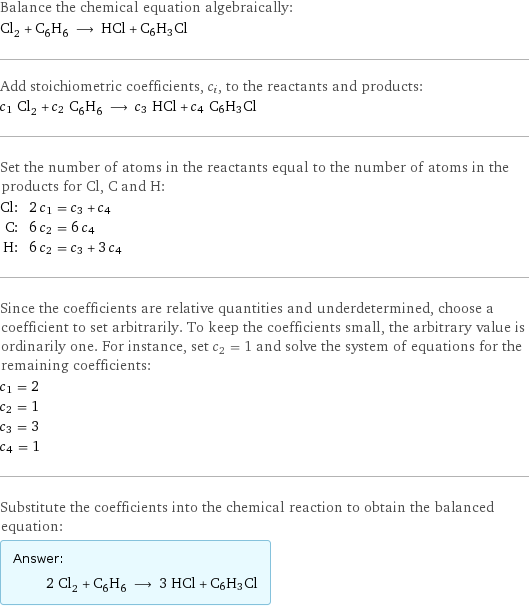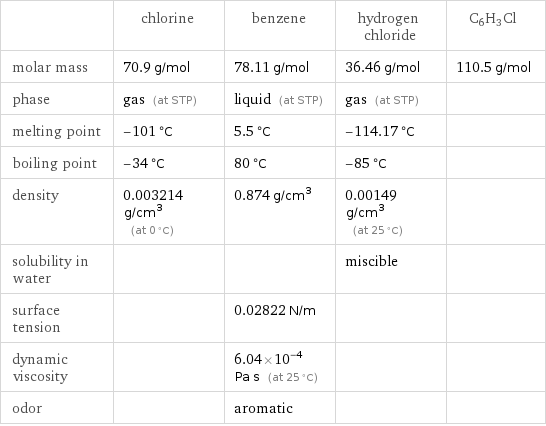Input interpretation

Cl_2 chlorine + C_6H_6 benzene ⟶ HCl hydrogen chloride + C6H3Cl
Balanced equation

Balance the chemical equation algebraically: Cl_2 + C_6H_6 ⟶ HCl + C6H3Cl Add stoichiometric coefficients, c_i, to the reactants and products: c_1 Cl_2 + c_2 C_6H_6 ⟶ c_3 HCl + c_4 C6H3Cl Set the number of atoms in the reactants equal to the number of atoms in the products for Cl, C and H: Cl: | 2 c_1 = c_3 + c_4 C: | 6 c_2 = 6 c_4 H: | 6 c_2 = c_3 + 3 c_4 Since the coefficients are relative quantities and underdetermined, choose a coefficient to set arbitrarily. To keep the coefficients small, the arbitrary value is ordinarily one. For instance, set c_2 = 1 and solve the system of equations for the remaining coefficients: c_1 = 2 c_2 = 1 c_3 = 3 c_4 = 1 Substitute the coefficients into the chemical reaction to obtain the balanced equation: Answer: | | 2 Cl_2 + C_6H_6 ⟶ 3 HCl + C6H3Cl
Structures

+ ⟶ + C6H3Cl
Names

chlorine + benzene ⟶ hydrogen chloride + C6H3Cl
Equilibrium constant
![Construct the equilibrium constant, K, expression for: Cl_2 + C_6H_6 ⟶ HCl + C6H3Cl Plan: • Balance the chemical equation. • Determine the stoichiometric numbers. • Assemble the activity expression for each chemical species. • Use the activity expressions to build the equilibrium constant expression. Write the balanced chemical equation: 2 Cl_2 + C_6H_6 ⟶ 3 HCl + C6H3Cl Assign stoichiometric numbers, ν_i, using the stoichiometric coefficients, c_i, from the balanced chemical equation in the following manner: ν_i = -c_i for reactants and ν_i = c_i for products: chemical species | c_i | ν_i Cl_2 | 2 | -2 C_6H_6 | 1 | -1 HCl | 3 | 3 C6H3Cl | 1 | 1 Assemble the activity expressions accounting for the state of matter and ν_i: chemical species | c_i | ν_i | activity expression Cl_2 | 2 | -2 | ([Cl2])^(-2) C_6H_6 | 1 | -1 | ([C6H6])^(-1) HCl | 3 | 3 | ([HCl])^3 C6H3Cl | 1 | 1 | [C6H3Cl] The equilibrium constant symbol in the concentration basis is: K_c Mulitply the activity expressions to arrive at the K_c expression: Answer: | | K_c = ([Cl2])^(-2) ([C6H6])^(-1) ([HCl])^3 [C6H3Cl] = (([HCl])^3 [C6H3Cl])/(([Cl2])^2 [C6H6])](../image_source/62632fb4edf67770b0ee20c56d39d692.png)
Construct the equilibrium constant, K, expression for: Cl_2 + C_6H_6 ⟶ HCl + C6H3Cl Plan: • Balance the chemical equation. • Determine the stoichiometric numbers. • Assemble the activity expression for each chemical species. • Use the activity expressions to build the equilibrium constant expression. Write the balanced chemical equation: 2 Cl_2 + C_6H_6 ⟶ 3 HCl + C6H3Cl Assign stoichiometric numbers, ν_i, using the stoichiometric coefficients, c_i, from the balanced chemical equation in the following manner: ν_i = -c_i for reactants and ν_i = c_i for products: chemical species | c_i | ν_i Cl_2 | 2 | -2 C_6H_6 | 1 | -1 HCl | 3 | 3 C6H3Cl | 1 | 1 Assemble the activity expressions accounting for the state of matter and ν_i: chemical species | c_i | ν_i | activity expression Cl_2 | 2 | -2 | ([Cl2])^(-2) C_6H_6 | 1 | -1 | ([C6H6])^(-1) HCl | 3 | 3 | ([HCl])^3 C6H3Cl | 1 | 1 | [C6H3Cl] The equilibrium constant symbol in the concentration basis is: K_c Mulitply the activity expressions to arrive at the K_c expression: Answer: | | K_c = ([Cl2])^(-2) ([C6H6])^(-1) ([HCl])^3 [C6H3Cl] = (([HCl])^3 [C6H3Cl])/(([Cl2])^2 [C6H6])
Rate of reaction
![Construct the rate of reaction expression for: Cl_2 + C_6H_6 ⟶ HCl + C6H3Cl Plan: • Balance the chemical equation. • Determine the stoichiometric numbers. • Assemble the rate term for each chemical species. • Write the rate of reaction expression. Write the balanced chemical equation: 2 Cl_2 + C_6H_6 ⟶ 3 HCl + C6H3Cl Assign stoichiometric numbers, ν_i, using the stoichiometric coefficients, c_i, from the balanced chemical equation in the following manner: ν_i = -c_i for reactants and ν_i = c_i for products: chemical species | c_i | ν_i Cl_2 | 2 | -2 C_6H_6 | 1 | -1 HCl | 3 | 3 C6H3Cl | 1 | 1 The rate term for each chemical species, B_i, is 1/ν_i(Δ[B_i])/(Δt) where [B_i] is the amount concentration and t is time: chemical species | c_i | ν_i | rate term Cl_2 | 2 | -2 | -1/2 (Δ[Cl2])/(Δt) C_6H_6 | 1 | -1 | -(Δ[C6H6])/(Δt) HCl | 3 | 3 | 1/3 (Δ[HCl])/(Δt) C6H3Cl | 1 | 1 | (Δ[C6H3Cl])/(Δt) (for infinitesimal rate of change, replace Δ with d) Set the rate terms equal to each other to arrive at the rate expression: Answer: | | rate = -1/2 (Δ[Cl2])/(Δt) = -(Δ[C6H6])/(Δt) = 1/3 (Δ[HCl])/(Δt) = (Δ[C6H3Cl])/(Δt) (assuming constant volume and no accumulation of intermediates or side products)](../image_source/40558b914d3ac93ef7a4fae506bec785.png)
Construct the rate of reaction expression for: Cl_2 + C_6H_6 ⟶ HCl + C6H3Cl Plan: • Balance the chemical equation. • Determine the stoichiometric numbers. • Assemble the rate term for each chemical species. • Write the rate of reaction expression. Write the balanced chemical equation: 2 Cl_2 + C_6H_6 ⟶ 3 HCl + C6H3Cl Assign stoichiometric numbers, ν_i, using the stoichiometric coefficients, c_i, from the balanced chemical equation in the following manner: ν_i = -c_i for reactants and ν_i = c_i for products: chemical species | c_i | ν_i Cl_2 | 2 | -2 C_6H_6 | 1 | -1 HCl | 3 | 3 C6H3Cl | 1 | 1 The rate term for each chemical species, B_i, is 1/ν_i(Δ[B_i])/(Δt) where [B_i] is the amount concentration and t is time: chemical species | c_i | ν_i | rate term Cl_2 | 2 | -2 | -1/2 (Δ[Cl2])/(Δt) C_6H_6 | 1 | -1 | -(Δ[C6H6])/(Δt) HCl | 3 | 3 | 1/3 (Δ[HCl])/(Δt) C6H3Cl | 1 | 1 | (Δ[C6H3Cl])/(Δt) (for infinitesimal rate of change, replace Δ with d) Set the rate terms equal to each other to arrive at the rate expression: Answer: | | rate = -1/2 (Δ[Cl2])/(Δt) = -(Δ[C6H6])/(Δt) = 1/3 (Δ[HCl])/(Δt) = (Δ[C6H3Cl])/(Δt) (assuming constant volume and no accumulation of intermediates or side products)
Chemical names and formulas

| chlorine | benzene | hydrogen chloride | C6H3Cl formula | Cl_2 | C_6H_6 | HCl | C6H3Cl Hill formula | Cl_2 | C_6H_6 | ClH | C6H3Cl name | chlorine | benzene | hydrogen chloride | IUPAC name | molecular chlorine | benzene | hydrogen chloride |
Substance properties

| chlorine | benzene | hydrogen chloride | C6H3Cl molar mass | 70.9 g/mol | 78.11 g/mol | 36.46 g/mol | 110.5 g/mol phase | gas (at STP) | liquid (at STP) | gas (at STP) | melting point | -101 °C | 5.5 °C | -114.17 °C | boiling point | -34 °C | 80 °C | -85 °C | density | 0.003214 g/cm^3 (at 0 °C) | 0.874 g/cm^3 | 0.00149 g/cm^3 (at 25 °C) | solubility in water | | | miscible | surface tension | | 0.02822 N/m | | dynamic viscosity | | 6.04×10^-4 Pa s (at 25 °C) | | odor | | aromatic | |
Units
